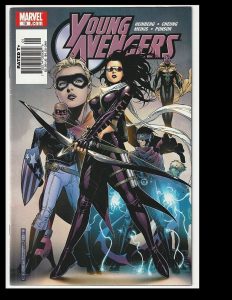 I am thrilled to introduce you to Marvel’s Young Avengers – a dynamic and powerful new generation of heroes. They are making their mark on the Marvel Cinematic Universe (MCU).
I am thrilled to introduce you to Marvel’s Young Avengers – a dynamic and powerful new generation of heroes. They are making their mark on the Marvel Cinematic Universe (MCU).
The Young Avengers step up to fill the void and carry on the legacy of Earth’s Mightiest Heroes. With their unique abilities and diverse backgrounds, these young heroes are proving themselves worthy successors to their formidable predecessors.
Join me as we delve into the rise of Marvel’s Young Avengers and explore their journey as they navigate the post-Endgame era of the MCU. Get ready to meet Kate Bishop, Kamala Khan, Cassie Lang, and other powerful young heroes who are set to redefine what it means to be a superhero.
Key Takeaways:
- Marvel’s Young Avengers represents a new generation of heroes in the MCU.
- They are taking up the mantle of Earth’s Mightiest Heroes as the original Avengers age or retire.
- The Young Avengers bring fresh perspectives and captivating storylines to the Marvel universe.
- Kate Bishop, Kamala Khan, Cassie Lang, and other members of the team showcase powerful abilities.
- The Young Avengers are shaping the future of the MCU and leaving a lasting impact on fans.
Rising from the Ashes of Endgame: The Arrival of Marvel’s New Heroes
After the epic events of Avengers: Endgame, the Marvel Cinematic Universe (MCU) entered Phase 4, ushering in a new generation of heroes. This exciting phase marked a turning point for the MCU, setting the stage for the emergence of Marvel’s new heroes, who would play a crucial role in the aftermath of Endgame.
The devastation caused by the events of Endgame left a void in the superhero landscape, with beloved characters retiring or meeting their demise. However, out of the ashes of this epic battle, a new wave of heroes rises to take up the mantle and continue the fight to protect the world.
Marvel’s new heroes bring fresh perspectives, diverse backgrounds, and incredible powers to the MCU. They represent a beacon of hope and serve as a reminder that even in the face of tragedy, a new generation of heroes will step up to safeguard our world.
Among these new heroes, the Young Avengers have emerged as a formidable force. They embody the spirit of the original Avengers while bringing their own unique strengths and abilities to the team. As the MCU charts a new course in Phase 4 and beyond, the Young Avengers will be at the forefront, forging their own path and shaping the future of the Marvel Universe.
| Keyword | Rising from the ashes of Endgame | Marvel’s new heroes | MCU Phase 4 | Avengers: Endgame aftermath |
| Description | Symbolizes the emergence of new heroes after Endgame’s destruction | Represents the fresh generation of superheroes joining the MCU | Refers to the new chapter in the MCU’s storytelling | Denotes the consequences and aftermath of the Avengers’ battle in Endgame |
The Legacy of the Original Avengers: Inspiring Marvel’s Young Avengers
The original Avengers have left a powerful legacy that continues to inspire a new generation of heroes in the Marvel Cinematic Universe. As the fallen Avengers pass the torch, the Young Avengers rise to carry on their mission of protecting the world and upholding the values of Earth’s Mightiest Heroes.
Continuing the Stories of the Fallen
The Young Avengers honor the legacies of the fallen Avengers by taking on their mantles, continuing their stories, and expanding upon their rich histories. With their diverse backgrounds and unique abilities, these young heroes bring fresh perspectives to the MCU, adding depth and complexity to the narratives that fans have come to love.
Youth Takes the Lead: The New Generation of Heroes
Inspired by their predecessors, the Young Avengers step into leadership positions, proving themselves worthy successors to the original Avengers. Their youthful energy and unwavering determination drive them to push boundaries, challenge norms, and navigate the complexities of a world still recovering from the aftermath of Avengers: Endgame.
| Avenger | Young Avenger | Inspired By |
|---|---|---|
| Captain America | Patriot | Steve Rogers |
| Iron Man | Ironheart | Tony Stark |
| Thor | Thor (Jane Foster) | Thor Odinson |
| Black Widow | Kate Bishop (Hawkeye) | Natasha Romanoff |
| Hawkeye | Cassie Lang (Stature) | Clint Barton |
The Young Avengers, led by characters like Patriot, Ironheart, Thor (Jane Foster), Kate Bishop (Hawkeye), and Cassie Lang (Stature), bring their own unique perspectives and abilities to the forefront. Through their compelling stories, they inspire audiences and demonstrate that true leadership knows no age or boundaries.
Marvel’s Young Avengers: New Generation of Heroes
Marvel’s Young Avengers is an exciting new generation of heroes in the Marvel Cinematic Universe (MCU). This dynamic superhero team is gaining popularity among audiences and is set to become a vital part of the future of the MCU. With their unique abilities, compelling storylines, and diverse backgrounds, the Young Avengers bring a fresh and captivating energy to the superhero universe.
The Young Avengers consist of fan-favorite characters who have captured the hearts of fans. They offer a fresh perspective and provide a platform for underrepresented audiences to see themselves represented in superhero narratives. These young heroes are breaking barriers and demonstrating the power of diversity and inclusivity in popular media.
With the imminent release of upcoming projects, fans can look forward to delving deeper into the stories of the Young Avengers. These projects will further explore the characters’ journeys, their growing powers, and their place in the expanding MCU. As the Young Avengers continue to evolve, their impact and influence on the superhero genre is set to grow exponentially.
Meet the Young Protectors of Marvel’s Cinematic Universe
In Marvel’s Cinematic Universe, the Young Avengers stand as a diverse group of heroes with unique abilities, ready to protect the world from threats. Let’s meet three prominent members of this young superhero team:
The Ingenious Kate Bishop: A New Hawkeye
Kate Bishop, known as Hawkeye, is a skilled archer who takes on the mantle of the original Hawkeye. With her exceptional marksmanship and quick thinking, she showcases her ingenuity and resourcefulness in battle. Kate brings a fresh perspective to the Young Avengers and proves herself as a vital member of the team.
Kamala Khan: Ms. Marvel and Mutant Hybrid
Kamala Khan, also known as Ms. Marvel, possesses shape-shifting abilities and is a mutant hybrid. She has the power to stretch, enlarge, or shrink her body at will, making her a versatile and formidable hero. Kamala adds diversity to the team and represents a new wave of representation and inclusivity in the Marvel Cinematic Universe.
Cassie Lang: From Adorable Child to Stature
Cassie Lang, the daughter of Ant-Man, grows from an adorable child to a superhero known as Stature. With the ability to change her size at will, she becomes a powerful force on the battlefield. Cassie’s growth demonstrates the potential of young heroes and their ability to step into their own as powerful individuals.
| Superhero | Abilities | |
|---|---|---|
| 1 | Kate Bishop | Skilled archer, ingenious |
| 2 | Kamala Khan | Shape-shifting, mutant hybrid |
| 3 | Cassie Lang | Size-changing, powerful force |
These young heroes, with their diverse backgrounds and remarkable abilities, deliver fresh perspectives and engaging storylines to the Marvel Cinematic Universe. As members of the Young Avengers, they show immense potential and contribute to the ever-expanding world of superhero storytelling.
Multiverse Merging: The Intersection of MCU’s Parallel Worlds
The concept of the multiverse is a key element in the Marvel Cinematic Universe (MCU) and will play a significant role in the future storylines of the Young Avengers. As the parallel worlds intersect, new opportunities for character development and team dynamics arise. The multiverse merging opens up a range of possibilities for the Young Avengers and allows for exciting crossovers and interactions with other Marvel characters. See also: The Marvel Effect.
From Comic Panels to the Big Screen: The Origins of the Young Avengers
The Young Avengers have their origins in the pages of Marvel Comics, where they were first introduced as a group of amateur vigilantes inspired by the original Avengers. This diverse team of young heroes quickly gained popularity among readers, thanks to their unconventional backgrounds and unique powers.
Young Avengers: The Birth in the Comics
The Young Avengers made their debut in the 2005 comic book series “Young Avengers” by writer Allan Heinberg and artist Jim Cheung. The series followed the adventures of these young heroes, who took on the mantle of Earth’s Mightiest Heroes and fought to protect the world from various threats.
Each member of the Young Avengers had their own compelling backstory and struggles, adding depth to their characters and driving their development throughout the series. Wiccan and Hulkling, for example, showcased a powerful love story, while Hawkeye brought a fresh and innovative take on the iconic archer character.
“The Young Avengers series was well-received by fans and critics, praised for its diverse cast of characters, engaging storytelling, and exploration of themes such as identity, family, and the burden of living up to the legacies of the original Avengers.”
Unconventional Heroes: The Diverse Background of Each Member
What set the Young Avengers apart from other superhero teams was their diverse backgrounds and identities. Each member brought a unique perspective and set of abilities to the group, making them a truly diverse and inclusive team.
For example, Kate Bishop, also known as Hawkeye, showcased her exceptional archery skills and quick wit. Kamala Khan, better known as Ms. Marvel, added a new dimension to the team with her shape-shifting abilities and Muslim Pakistani-American background. Cassie Lang, the daughter of Ant-Man, went from being an adorable child to becoming Stature, a superhero who can change her size at will.
These unconventional heroes represented different races, genders, and sexual orientations, providing a sense of representation and relatability for a wide range of readers. The Young Avengers proved that anyone can be a hero, regardless of their background or circumstances.
The transition of the Young Avengers from the comic panels to the big screen opens up new opportunities for their character development and exploration of their unique origins. Fans can look forward to seeing these diverse and compelling young heroes make their mark in the Marvel Cinematic Universe, bringing their powerful stories and abilities to a wider audience.
The Integration of Powerful Young Heroes into the MCU
The Marvel Cinematic Universe (MCU) has successfully integrated a new wave of young heroes, bringing a fresh perspective and adding depth to the existing superhero universe. These young heroes possess unique and formidable abilities, making them important contributors to the ever-expanding MCU. Through their character development and interactions with established MCU characters, they contribute to the overall narrative, creating exciting storylines that captivate fans.
Upcoming Projects: What’s Next for the Young Avengers?
The Young Avengers have a bright future ahead in the Marvel Cinematic Universe (MCU). With several upcoming projects in store, fans can look forward to further exploring the stories and character arcs of these young heroes. As they continue to evolve, the Young Avengers will take on new challenges and make significant contributions to the ever-expanding Marvel universe.
Confirmed Appearances in Future MCU Phases
The Young Avengers have been confirmed to appear in future MCU phases, solidifying their importance in the ongoing narrative. Fans can anticipate seeing these young heroes in action as they join forces with other iconic characters and face off against powerful adversaries. The inclusion of the Young Avengers in future MCU phases promises exciting team dynamics and thrilling superhero moments.
Evolving Narratives and Upcoming Character Arcs
As the MCU progresses, the Young Avengers will experience evolving narratives and captivating character arcs. Audiences can expect to witness the growth and development of these young heroes as they face personal challenges, embrace their unique abilities, and come into their own. The upcoming projects will offer deeper insights into their individual journeys and the team dynamics that define the Young Avengers.
The Significance of Diverse Representation in Superhero Teams
The Young Avengers represent a significant step towards diverse representation in superhero teams. The inclusion of characters with different backgrounds, ethnicities, and identities promotes inclusivity and provides underrepresented audiences with characters they can relate to. The significance of diverse representation in superhero teams cannot be overstated, as it sends a powerful message about the importance of inclusivity and representation in popular media.
More popular titles about comic book collecting:
- What is the Best Way to Collect Comic Books
- Discovering Rare Comic Books
- Tips for Building Your Comic Book Collection
Conclusion
Marvel’s Young Avengers represent a new generation of heroes in the Marvel Cinematic Universe (MCU), bringing fresh perspectives, diverse backgrounds, and powerful abilities to the superhero universe. With the original Avengers aging or retiring, the Young Avengers are stepping up to fill the void and continue the legacy of Earth’s Mightiest Heroes. As the MCU continues to evolve and expand, the Young Avengers are poised to play a central role in future storytelling.
These young heroes have already captured the hearts of fans with their engaging storylines and relatable characters. From Kate Bishop’s ingenious archery skills as the new Hawkeye, to Kamala Khan’s shape-shifting abilities as Ms. Marvel, and Cassie Lang’s transformation from an adorable child to the powerful Stature, the Young Avengers bring a fresh and diverse perspective to the MCU.
The future holds great promise for the Young Avengers, as they embark on new adventures and face new challenges in the Marvel Cinematic Universe. Their powerful abilities, compelling stories, and relatable characters ensure that they will become fan favorites and leave a lasting impact on the superhero genre. As the MCU continues to tell captivating stories, the Young Avengers will undoubtedly be at the forefront, showcasing the potential of the new generation of heroes.
FAQ
Who are the Young Avengers?
The Young Avengers are a superhero team that represents the new generation of heroes in the Marvel Cinematic Universe (MCU). This diverse group of young heroes is taking up the mantle of Earth’s Mightiest Heroes and bringing a fresh perspective to the MCU.
What role do the Young Avengers play in the post-Endgame era?
With the original Avengers aging or retiring, the Young Avengers are rising to fill the void and continue their mission to protect the world. They carry on the legacy of the fallen Avengers and bring a new wave of heroes to the forefront of the MCU.
Which fan-favorite characters are part of the Young Avengers?
The Young Avengers consist of popular characters such as Kate Bishop (Hawkeye), Kamala Khan (Ms. Marvel), and Cassie Lang (Stature). Each character brings their unique abilities and compelling storylines to the team.
Will the Young Avengers be featured in upcoming MCU projects?
Yes, fans can look forward to upcoming projects that will further explore the stories and character arcs of the Young Avengers. They are confirmed to appear in future phases of the Marvel Cinematic Universe, providing exciting opportunities for their narratives to develop.
What is the significance of diverse representation in the Young Avengers?
The inclusion of characters with different backgrounds, ethnicities, and identities in the Young Avengers promotes inclusivity and gives underrepresented audiences characters they can relate to. It sends a powerful message about the importance of representation in popular media.

